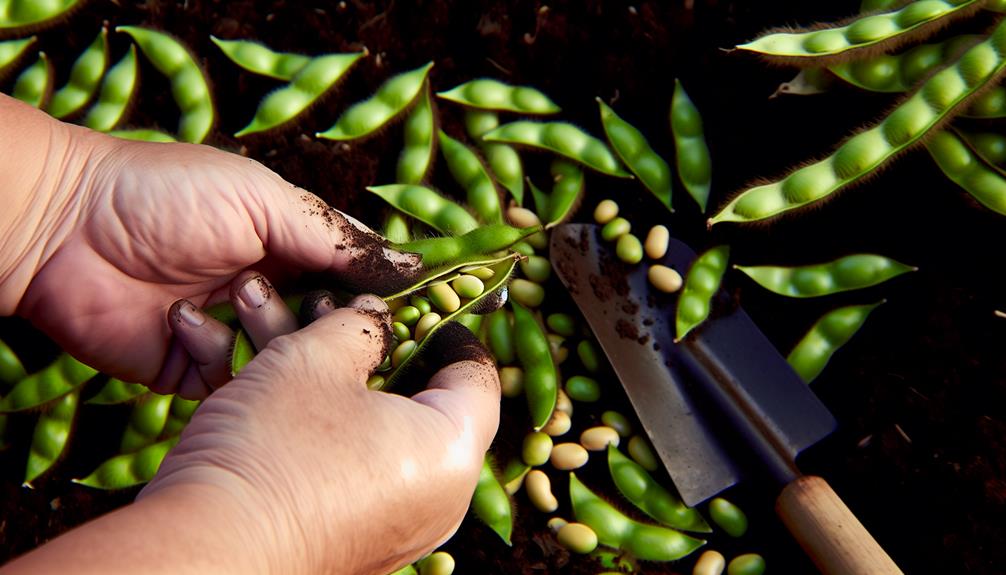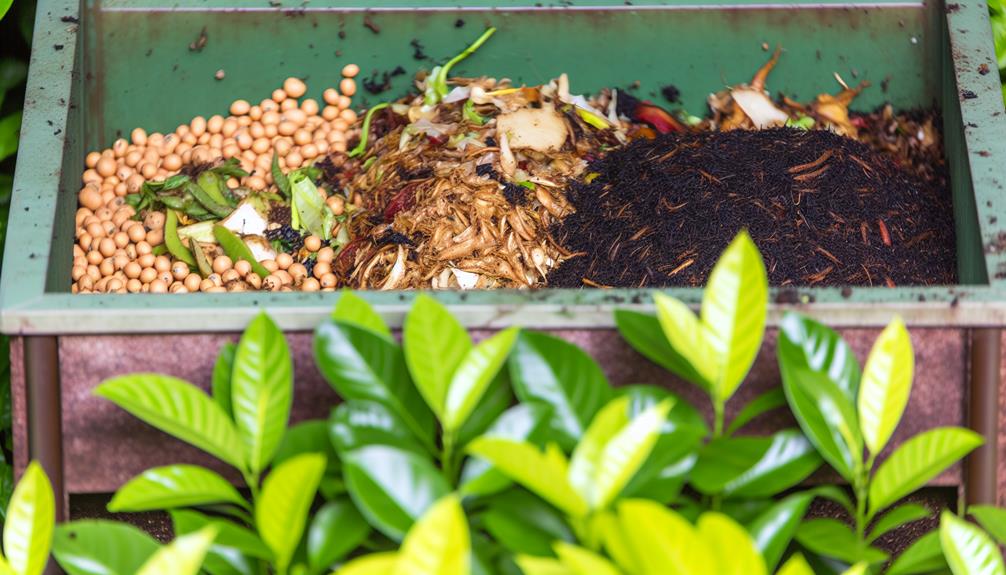

You can compost soy beans, but you’ll need to take some extra steps. Break the beans into smaller pieces to speed up their decomposition. Soy beans are rich in nitrogen, which can upset the balance in your compost pile, so mix them with carbon-heavy materials like leaves or straw.
Make sure you turn your compost regularly to promote airflow and maintain ideal moisture levels. Soy beans decompose slowly, so be patient and monitor the pile closely. By balancing the carbon-nitrogen ratio and maintaining proper conditions, you’ll enhance your compost’s quality. Learn about maintaining a balanced compost for more details.
Composting soy beans enriches your soil with essential nutrients, enhancing plant growth and health. When you compost soy beans, you’re engaging in nutrient recycling, returning valuable minerals and organic matter back into the soil. This process improves soil structure, increases its ability to retain moisture, and supports the growth of beneficial microorganisms.
To start composting soy beans, you should first break them down into smaller pieces. This will speed up the decomposition process. Mix the soy beans with other compost materials like vegetable scraps, coffee grounds, and yard waste. Aim for a balanced ratio of green (nitrogen-rich) and brown (carbon-rich) materials. This balance is vital for effective composting and soil enrichment.
Turn your compost pile regularly to aerate it, which helps the organic matter decompose more efficiently. Keeping the compost moist but not waterlogged is also important for maintaining the right conditions for the microorganisms involved in breaking down the materials.
Over time, your compost will transform into a dark, crumbly substance that can be mixed into garden beds or used as a top dressing for plants, providing them with the nutrients they need to thrive.
When composting soy beans, you need to watch out for a couple of potential issues.
First, their high protein content can attract unwanted pests.
Additionally, soy beans have a slow decomposition rate, which means you might need to adjust your composting process.
High protein content in soybeans can slow down the composting process because it attracts more nitrogen-consuming bacteria. Soybeans are nutrient-dense, packed with amino acids that make them a rich source of protein. While this nutrient density is excellent for your diet, it poses challenges for your compost pile.
When you add soybeans to your compost, the high protein content leads to an increase in nitrogen levels. This attracts bacteria that thrive on nitrogen, which can upset the balance needed for efficient composting.
To manage this, you should balance the nitrogen-rich soybeans with carbon-rich materials like dry leaves, straw, or cardboard. This helps maintain the carbon-to-nitrogen ratio that composting microorganisms need. Aim for a ratio of about 30 parts carbon to 1 part nitrogen.
Turning your compost regularly will also help aerate the pile and speed up the breakdown process.
Balancing soybeans’ high protein content is just one challenge; their slow decomposition rate can also hinder your composting efforts. Soybeans break down more slowly than other compostable items due to their dense structure and higher oil content, affecting your compost’s efficiency. This slow decomposition can disrupt the bacterial activity needed for a healthy compost pile.
To address this, you can take specific steps to boost the microbial population and accelerate the breakdown process. To begin with, chop or crush the soybeans before adding them to your compost. This increases the surface area, making it easier for microbes to do their job. Additionally, mix the soybeans with other nitrogen-rich materials to balance out their high protein content. This mix will enhance bacterial activity.
Here’s a helpful table to guide you:
| Step | Action | Benefit |
|---|---|---|
| 1. Chop/crush | Increase surface area | Speeds up decomposition |
| 2. Mix | Combine with greens | Balances nitrogen levels |
| 3. Aerate | Turn compost regularly | Boosts microbial population |
| 4. Monitor | Check moisture levels | Ensures ideal bacterial activity |
Also Read: Can You Compost Cat Feces?
Before adding soy beans to your compost pile, make sure they’re broken down into smaller pieces to speed up decomposition. This is important because whole soy beans can take a long time to break down, slowing your composting process.

Start by considering different cooking methods and soaking techniques. Cooking the soy beans, for instance, can soften them greatly, making them easier to chop into smaller bits. You can boil them until they’re tender, which will also help to kill any potential pathogens.
If cooking isn’t an option, soaking techniques work well too. Soak the soy beans in water for 12-24 hours. This will plump them up and make them easier to handle. After soaking, drain the water and chop the beans into smaller pieces. You might find it helpful to use a food processor for this step, ensuring the pieces are small enough to decompose quickly.
Balancing your compost pile is essential for efficient decomposition.
You need to pay attention to the carbon-nitrogen ratio, control moisture levels, and guarantee proper aeration.
To achieve effective composting, you need to maintain the right carbon-nitrogen ratio in your pile. This balance is essential for ideal microbial activity, which directly influences compost quality. Typically, a ratio of 30:1 (carbon to nitrogen) works best. Materials high in carbon, like dried leaves or straw, pair well with nitrogen-rich items like soybeans.
When you add soybeans to your compost, you’re introducing a nitrogen source. Be sure to harmonize it with carbon-heavy materials. Think of it as feeding your compost pile – too much nitrogen can make it smell, while too much carbon can slow down decomposition. By mixing both types, you create the perfect environment for microbes to thrive.
Alongside maintaining the right carbon-nitrogen ratio, you must also manage moisture levels to guarantee your compost pile stays healthy and active. Composting soybeans, like any other organic material, requires a balance between wet and dry components.
The ideal moisture level should be about as damp as a wrung-out sponge. Too much water can drown the microorganisms essential for decomposition, while too little can halt the process altogether.
To help you assure the right moisture balance, consider the water retention properties of different materials you add to your compost pile. Soybeans, for example, have moderate water retention, meaning they’ll contribute to the moisture level but won’t saturate the pile.
Here’s a quick guide to understanding the water retention of various compost materials:
| Material | Water Retention Level |
|---|---|
| Soybeans | Moderate |
| Dry Leaves | Low |
| Fruit Scraps | High |
| Wood Chips | Low |
Regularly check your compost’s moisture by grabbing a handful and squeezing it. If water drips out, it’s too wet; if it crumbles, it’s too dry. Adjust by adding more dry or wet materials accordingly. By monitoring and adjusting moisture levels, you’ll foster a thriving compost environment that efficiently breaks down soybeans and other organic matter.
Proper aeration is essential for maintaining a balanced compost pile and ensuring efficient decomposition. To achieve this, you’ll need to pay attention to turning frequency and consider using air pumps.
Turning your compost pile regularly helps introduce oxygen, which is crucial for aerobic microorganisms that break down organic matter. Aim to turn your pile at least once a week, but more frequent turning can accelerate the process.
If you find turning the pile manually too demanding, air pumps can be a useful alternative. These devices introduce oxygen directly into the pile, reducing the need for frequent manual turning. Position air pumps strategically within your compost to ensure even distribution of air.
Remember, the goal is to maintain a balance. Too much turning can dry out the pile, while too little can lead to anaerobic conditions and unpleasant odors. Monitor your compost and adjust the turning frequency accordingly. Additionally, ensure that your compost pile is well-structured, with a mix of different-sized materials to allow air to flow freely.
Also Read: Can You Compost Celery?
When composting soybeans, you’ll find that the time frame typically ranges from three to six months. To achieve this, maintaining the ideal temperature of your compost pile is essential. Aim for a range between 135°F and 160°F.
This guarantees that the microorganisms responsible for breaking down organic material remain active and efficient. By doing so, you’ll effectively manage the compost lifespan, transforming your soybeans into rich compost in a timely manner.

Start by balancing your compost pile with green and brown materials. Soybeans fall under the green category, providing essential nitrogen. Mix them with brown materials like dried leaves or straw, which supply carbon.
Turn your pile regularly, at least once a week, to maintain aeration and avoid any unpleasant odors. This practice also helps distribute heat evenly, fostering an environment where decomposition can thrive.
Keep an eye on moisture levels, ensuring the pile feels like a damp sponge. Too much moisture can slow the process, while too little can halt it altogether.
You can tell your composting efforts are successful when the pile transforms into a dark, crumbly, and earthy-smelling material.
Achieving this involves careful attention to several key signs that indicate your compost is on the right track.
Also Read: Can You Compost Cabbage?
Beyond composting, soy beans offer a plethora of alternative uses that can enrich your daily life and diet. If you’re looking to diversify your sustainable practices, consider these options.
First, soy beans make excellent animal feed. Rich in protein, they provide essential nutrients for livestock, poultry, and even fish. By using soy beans in your animal feed, you’re ensuring a balanced diet for your farm animals, promoting their health and productivity.
Another innovative use is creating soy based fertilizers. These fertilizers can greatly enhance soil quality due to their high nitrogen content. By applying soy based fertilizers, you improve soil fertility and promote healthy plant growth, contributing to a more sustainable gardening practice.
For those keen on culinary adventures, soy beans are a versatile ingredient. From tofu to soy milk, they can be transformed into various delicious and nutritious foods. Incorporating soy beans into your diet can boost your protein intake and offer numerous health benefits.
Incorporating these alternative uses of soy beans into your routine not only strengthens your connection to sustainable living but also fosters a sense of community among those working towards eco-friendly practices.
You can compost cooked soy beans. Their nutrient content enriches your compost, but keep in mind they might take longer to decompose. Your garden community will appreciate the added nutrients and improved soil quality.
When composting soy beans, there’s a chance you’ll encounter soy pests. The attraction risks are manageable with proper composting techniques. By maintaining balance and covering scraps, you can keep your compost community free from unwanted visitors.
You might wonder if soy beans affect the compost’s pH level. They won’t drastically change soil acidity, but their decomposition rate can slightly influence it, fostering a balanced compost pile that everyone in the community will benefit from.
Yes, you can compost moldy soy beans, but be cautious. Mold spores thrive in cooler conditions. Make sure your compost temperature stays high to kill off any unwanted pathogens and keep your compost community healthy.
Soy beans offer high nutrient content and decompose quicker than some other legumes, enriching your compost faster. Including them in your compost pile guarantees you’re creating a robust, nutrient-rich environment for your garden community.
To sum up, composting soy beans can greatly enrich your compost pile, but it’s important to prepare them properly and maintain a balanced mix of materials.
Make sure to chop the beans, mix them with carbon-rich materials, and monitor the compost’s moisture and aeration. By doing so, you’ll guarantee a successful composting process.
Remember, patience is key as decomposition takes time. When done right, you’ll have nutrient-rich compost ready to enhance your garden.
